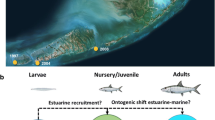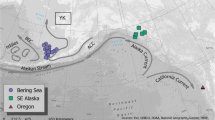Abstract
Movements undertaken by marine organisms occur for varying reasons and knowledge surrounding them is critically important for understanding population structures, ecology and for effective management and conservation of species. The objective of this study was to test a hypothesis that the cubozoan jellyfish Alatina alata spends a large part of its life at great depths by utilising the recently validated technique of statolith elemental chemistry. The approach was to ground-truth estimates of temperature based on a previous manipulative laboratory-based experiment, determine Sr:Ca and Ba:Ca ratios in the statoliths of A. alata at different life-history stages and use elemental chemistry as an environmental marker to estimate their life-time movements. High Sr:Ca values in the core and edge of the statoliths were found which corresponded with the time jellyfish were in shallow waters. Ambient water temperatures estimated for the end period of the jellyfish’s lives closely matched known sea surface temperatures in Hawaii, hence supporting a correlation between statolith Sr:Ca and temperature. For the middle section of the statoliths, strong evidence from both Sr:Ca and Ba:Ca ratios suggested that the jellyfish reached depths of at least 200–400 m. Ba:Sr maxima further supported this as Ba concentrations are usually higher below the thermocline. Individual Sr:Ca tracks also suggested that individuals moved over a depth range of tens to hundreds of meters through undertaking regular vertical movements. This study demonstrates that the use of elemental chemistry within cubozoan statoliths has the potential to determine vertical and horizontal movements where temperature gradients are strong.





Similar content being viewed by others
Data availability
The datasets generated during and/or analysed during the current study are available from the corresponding author on reasonable request.
References
Arkhipkin AI, Campana SE, FitzGerald J, Thorrold SR (2004) Spatial and temporal variation in elemental signatures of statoliths from the Patagonian longfin squid (Loligo gahi). Can J Fish Aquat Sci 61:1212–1224
Beck JW, Edwards RL, Ito E, Taylor FW, Recy J, Rougerie F, Joannot P, Henin C (1992) Sea-surface temperature from coral skeletal strontium/calcium ratios. Science 257:644–647
Bruland K, Lohan M (2006) Controls of trace metals in seawater. Oceans Mar Geochem 6:23–47
Campana SE (1999) Chemistry and composition of fish otoliths: pathways, mechanisms and applications. Mar Ecol Prog Ser 188:263–297
Campana SE, Thorrold SR (2001) Otoliths, increments, and elements: keys to a comprehensive understanding of fish populations? Can J Fish Aquat Sci 58:30–38
Chiaverano LM, Holland BS, Crow GL, Blair L, Yanagihara AA (2013) Long-term fluctuations in circalunar beach aggregations of the box jellyfish Alatina moseri in Hawaii, with links to environmental variability. PLoS ONE 8:e77039
De Villiers S, Shen GT, Nelson BK (1994) The SrCa–temperature relationship in coralline aragonite: influence of variability in (SrCa) seawater and skeletal growth parameters. Geochim Cosmochim Acta 58:197–208
Elsdon TS, Gillanders BM (2003) Reconstructing migratory patterns of fish based on environmental influences on otolith chemistry. Re Fish Biol Fish 13:217–235
Elsdon TS, Wells BK, Campana SE, Gillanders BM, Jones CM, Limburg KE, Secor DH, Thorrold SR, Walther BD (2008) Otolith chemistry to describe movements and life-history parameters of fishes: hypotheses, assumptions, limitations and inferences. Oceanography and marine biology. CRC Press, Boca Raton, pp 303–336
Fowler AJ, Campana SE, Thorrold SR, Jones CM (1995) Experimental assessment of the effect of temperature and salinity on elemental composition of otoliths using laser ablation ICPMS. Can J Fish Aquat Sci 52:1431–1441
Frank KT, Page FH, McRuer JK (1989) Hydrographic effects on the vertical distribution of haddock (Melanogrammus aeglefinus) eggs and larvae on the southwestern Scotian Shelf. Can J Fish Aquat Sci 46:s82–s92
Garm A, Bielecki J, Petie R, Nilsson D-E (2012) Opposite patterns of diurnal activity in the box jellyfish Tripedalia cystophora and Copula sivickisi. Biol Bull 222:35–45
Gershwin L-A, Richardson AJ, Winkel KD, Fenner PJ, Lippmann J, Hore R, Avila-Soria G, Brewer D, Kloser RJ, Steven A (2013) Biology and ecology of Irukandji jellyfish (Cnidaria: Cubozoa). Advances in marine biology. Elsevier, Amsterdam, pp 1–85
Gibson R, Barnes M, Atkinson R (2001) Selective tidal-stream transport of marine animals. Oceanogr Mar Biol Annu Rev 39:305–353
Gillanders BM, Able KW, Brown JA, Eggleston DB, Sheridan PF (2003) Evidence of connectivity between juvenile and adult habitats for mobile marine fauna: an important component of nurseries. Mar Ecol Prog Ser 247:281–295
Gordon M, Seymour J (2012) Growth, development and temporal variation in the onset of six Chironex fleckeri medusae seasons: a contribution to understanding jellyfish ecology. PLoS ONE 7:e31277
Gordon M, Hatcher C, Seymour J (2004) Growth and age determination of the tropical Australian cubozoan Chiropsalmus sp. Hydrobiologia 530:339–345
Harris RP (1988) Interactions between diel vertical migratory behavior of marine zooplankton and the subsurface chlorophyll maximum. Bull Mar Sci 43:663–674
Hays GC (2003) A review of the adaptive significance and ecosystem consequences of zooplankton diel vertical migrations. Migrations and dispersal of marine organisms. Springer, Berlin, pp 163–170
Heath M, Henderson E, Baird D (1988) Vertical distribution of herring larvae in relation to physical mixing and illumination. Mar Ecol Prog Ser 47:211–228
Horner TJ, Kinsley CW, Nielsen SG (2015) Barium-isotopic fractionation in seawater mediated by barite cycling and oceanic circulation. Earth Planet Sci Lett 430:511–522
Ikeda Y, Arai N, Sakamoto W, Kodokoro H, Yoshida K (1998) Microchemistry of the statoliths of the Japanese common squid Todarodes pacificus with special reference to its relation to the vertical temperature profiles of squid habitat. Fish Sci 64:179–184
Jacquet S, Dehairs F, Rintoul S (2004) A high resolution transect of dissolved barium in the Southern Ocean. Geophys Res Lett. https://doi.org/10.1029/2004GL020016
Karl DM, Lukas R (1996) The Hawaii Ocean Time-series (HOT) program: background, rationale and field implementation. Deep Sea Res (2 Top Stud Oceangr) 43:129–156
Kawamura M, Ueno S, Iwanaga S, Oshiro N, Kubota S (2003) The relationship between fine rings in the statolith and growth of the cubomedusa Chiropsalmus quadrigatus (Cnidaria: Cubozoa) from Okinawa Island, Japan. Plankton Biol Ecol 50:37–42
Kingsford MJ, Mooney CJ (2014) The ecology of box jellyfishes (Cubozoa). Jellyfish blooms. Springer, Berlin, pp 267–302
Kingsford MJ, Leis JM, Shanks A, Lindeman KC, Morgan SG, Pineda J (2002) Sensory environments, larval abilities and local self-recruitment. Bull Mar Sci 70:309–340
Lawley JW, Ames CL, Bentlage B, Yanagihara A, Goodwill R, Kayal E, Hurwitz K, Collins AG (2016) Box jellyfish Alatina alata has a circumtropical distribution. Biol Bull 231:152–169
Lewis C, Bentlage B, Yanagihara A, Gillan W, Van Blerk J, Keil DP, Bely AE, Collins AG (2013) Redescription of Alatina alata (Reynaud, 1830) (Cnidaria: Cubozoa) from Bonaire, Dutch Caribbean. Zootaxa 3737:473
Little M, Pereira P, Carrette T, Seymour J (2006) Jellyfish responsible for Irukandji syndrome. J Assoc Phys 99:425–427
Lobel P, Robinson A (1986) Transport and entrapment of fish larvae by ocean mesoscale eddies and currents in Hawaiian waters. Deep Sea Res Pt A 33:483–500
Lobel PS, Robinson AR (1988) Larval fishes and zooplankton in a cyclonic eddy in Hawaiian waters. J Plankton Res 10:1209–1223
McCulloch MT, Gagan MK, Mortimer GE, Chivas AR, Isdale PJ (1994) A high-resolution Sr/Ca and δ18O coral record from the Great Barrier Reef, Australia, and the 1982–1983 El Niño. Geochim Cosmochim Acta 58:2747–2754
McCulloch M, Cappo M, Aumend J, Müller W (2005) Tracing the life history of individual barramundi using laser ablation MC-ICP-MS Sr-isotopic and Sr/Ba ratios in otoliths. Mar Freshw Res 56:637–644
Menéndez MC, Piccolo MC, Hoffmeyer MS (2012) Short-term variability on mesozooplankton community in a shallow mixed estuary (Bahía Blanca, Argentina): influence of tidal cycles and local winds. Estuar Coast Shelf Sci 112:11–22
Mooney C, Kingsford M (2012) Sources and movements of Chironex fleckeri medusae using statolith elemental chemistry. Jellyfish blooms IV. Springer, Berlin, pp 269–277
Mooney CJ, Kingsford MJ (2016) The influence of salinity on box jellyfish (Chironex fleckeri, Cubozoa) statolith elemental chemistry. Mar Biol 163:103
Morrissey SJ, Schlaefer JA, Kingsford MJ (2020) Experimental validation of the relationships between cubozoan statolith elemental chemistry and salinity and temperature. J Exp Mar Biol Ecol 527:151375
Seymour JE, Carrette TJ, Sutherland PA (2004) Do box jellyfish sleep at night? Med J Aust 181:706
Shen C-C, Lee T, Chen C-Y, Wang C-H, Dai C-F, Li L-A (1996) The calibration of D [Sr/Ca] versus sea surface temperature relationship for Porites corals. Geochim Cosmochim Acta 60:3849–3858
Sih TL, Cappo M, Kingsford M (2017) Deep-reef fish assemblages of the Great Barrier Reef shelf-break (Australia). Sci Rep 7:10886
Sinclair M, Iles T (1989) Population regulation and speciation in the oceans. ICES J Mar Sci 45:165–175
Sinclair DJ, McCulloch MT (2004) Corals record low mobile barium concentrations in the Burdekin River during the 1974 flood: evidence for limited Ba supply to rivers? Palaeogeogr Palaeoclimatol Palaeoecol 214:155–174
Stern SJ (2009) Migration and movement patterns. Encyclopedia of marine mammals. Elsevier, Amsterdam, pp 726–730
Strzelecki J, Koslow J, Waite A (2007) Comparison of mesozooplankton communities from a pair of warm-and cold-core eddies off the coast of Western Australia. Deep Sea Res (2 Top Stud Oceaogr) 54:1103–1112
Tabouret H, Bareille G, Claverie F, Pécheyran C, Prouzet P, Donard O (2010) Simultaneous use of strontium: calcium and barium: calcium ratios in otoliths as markers of habitat: application to the European eel (Anguilla anguilla) in the Adour basin, South West France. Mar Environ Res 70:35–45
Thorrold SR, Jones GP, Hellberg ME, Burton RS, Swearer SE, Neigel JE, Morgan SG, Warner RR (2002) Quantifying larval retention and connectivity in marine populations with artificial and natural markers. Bull Mar Sci 70:291–308
Ueno S, Imai C, Mitsutani A (1995) Fine growth rings found in statolith of a cubomedusa Carybdea rastoni. J Plankton Res 17:1381–1384
Underwood AJ, Underwood AJ, Wnderwood A (1997) Experiments in ecology: their logical design and interpretation using analysis of variance. CUP, Cambridge
Walther B, Limburg K (2012) The use of otolith chemistry to characterize diadromous migrations. J Fish Biol 81:796–825
Walther BD, Kingsford MJ, McCulloch MT (2013) Environmental records from Great Barrier Reef corals: Inshore versus offshore drivers. PLoS ONE 8:e77091
Wolanski E, Delesalle B (1995) Upwelling by internal waves, Tahiti, French Polynesia. Cont Shelf Res 15:357–368
Woodhead JD, Hellstrom J, Hergt JM, Greig A, Maas R (2007) Isotopic and elemental imaging of geological materials by laser ablation inductively coupled plasma-mass spectrometry. Geostand Geoanal Res 31:331–343
Yoshimoto CM, Yanagihara AA (2002) Cnidarian (coelenterate) envenomations in Hawai'i improve following heat application. Trans R Soc Trop Med Hyg 96:300–303
Acknowledgements
The authors thank Yi Hu at AAC for assistance with LA-ICPMS and Mark O’Callaghan for added assistance. The authors also thank the reviewers for commenting on drafts of this manuscript. This project was supported by funding from the ARC Centre of Excellence for Coral Reef Studies to MJK.
Author information
Authors and Affiliations
Corresponding author
Ethics declarations
Conflict of interest
The authors declare that they have no conflicts of interests.
Human and animals rights statement
All applicable international, national and/or institutional guidelines for sampling, care and experimental use of organisms for the study have been followed and all necessary approvals have been obtained.
Additional information
Responsible Editor: A. Checa.
Publisher's Note
Springer Nature remains neutral with regard to jurisdictional claims in published maps and institutional affiliations.
Reviewed by undisclosed experts.
Rights and permissions
About this article
Cite this article
Morrissey, S.J., Yanagihara, A.A. & Kingsford, M.J. Utility of statolith elemental chemistry as a proxy for temperature to elucidate the movements of the Irukandji jellyfish species Alatina alata. Mar Biol 167, 134 (2020). https://doi.org/10.1007/s00227-020-03752-4
Received:
Accepted:
Published:
DOI: https://doi.org/10.1007/s00227-020-03752-4




